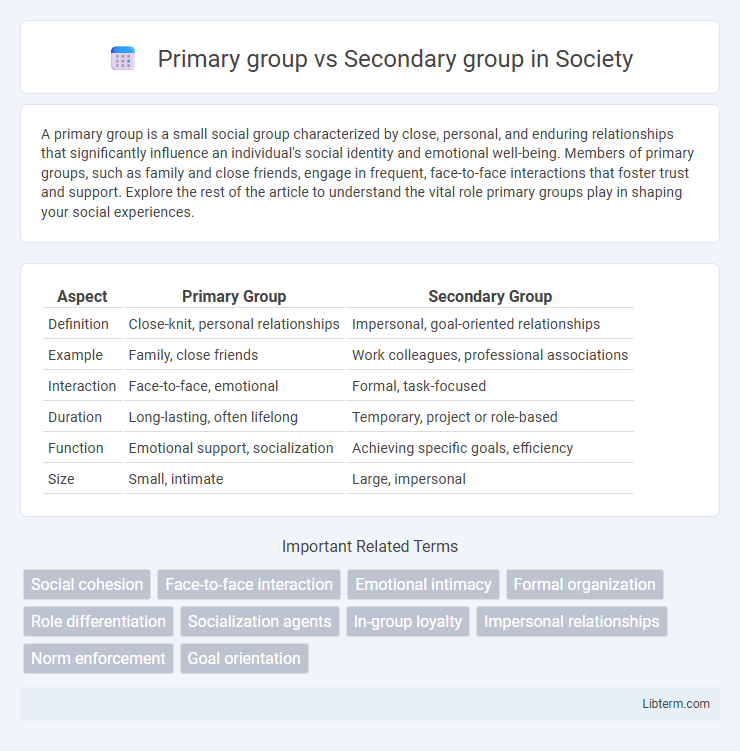A primary group is a small social group characterized by close, personal, and enduring relationships that significantly influence an individual's social identity and emotional well-being. Members of primary groups, such as family and close friends, engage in frequent, face-to-face interactions that foster trust and support. Explore the rest of the article to understand the vital role primary groups play in shaping your social experiences.
Table of Comparison
| Aspect | Primary Group | Secondary Group |
|---|---|---|
| Definition | Close-knit, personal relationships | Impersonal, goal-oriented relationships |
| Example | Family, close friends | Work colleagues, professional associations |
| Interaction | Face-to-face, emotional | Formal, task-focused |
| Duration | Long-lasting, often lifelong | Temporary, project or role-based |
| Function | Emotional support, socialization | Achieving specific goals, efficiency |
| Size | Small, intimate | Large, impersonal |
Understanding Social Groups: Primary vs. Secondary
Primary groups are small, close-knit, and characterized by intimate, personal relationships that shape individuals' identities and socialization, such as family and close friends. Secondary groups involve larger, more impersonal connections based on specific goals or activities, like coworkers or members of professional organizations. Understanding the differences between these groups helps analyze social behavior, influence, and network dynamics within various social structures.
Defining Primary Groups
Primary groups are small, close-knit social groups characterized by intimate, face-to-face interactions and strong emotional ties, such as family and close friends. They play a crucial role in shaping an individual's identity, social norms, and values through sustained personal contact and emotional support. The significance of primary groups lies in their influence on socialization, providing members with a sense of belonging and security.
Defining Secondary Groups
Secondary groups consist of larger, impersonal social groups formed to achieve specific goals or tasks, often characterized by formal, structured relationships and limited emotional depth. Unlike primary groups, which emphasize close, personal bonds and long-term connections, secondary groups focus on efficiency and role-based interactions in settings such as workplaces, organizations, or institutions. Examples include professional associations, clubs, and bureaucracies, where members interact to fulfill collective objectives rather than personal needs.
Key Characteristics of Primary Groups
Primary groups are characterized by close, personal, and enduring relationships that foster emotional depth and strong social bonds. These groups, often family or close friends, provide essential support, socialization, and a sense of belonging. The interactions within primary groups are typically face-to-face, informal, and involve a high degree of intimacy and trust.
Key Characteristics of Secondary Groups
Secondary groups are characterized by large, impersonal, and goal-oriented relationships where interactions are often formal and task-focused. Members typically engage in limited emotional involvement, emphasizing efficiency and achieving specific objectives. These groups are common in workplaces, professional organizations, and large institutions, fostering cooperation without deep personal bonds.
Functions of Primary Groups in Society
Primary groups serve essential functions in society by providing emotional support, socialization, and a sense of belonging. These groups, typically consisting of close-knit relationships like family and close friends, foster personal identity and social norms through direct, intimate interactions. Their influence is crucial for individual development and maintaining social cohesion within communities.
Functions of Secondary Groups in Society
Secondary groups serve essential functions in society by facilitating specialized roles and goal-oriented interactions among individuals who share less personal and more formal relationships. These groups contribute to social organization by promoting cooperation, coordinating activities, and providing a structure for achieving collective objectives such as professional development, education, and economic production. Their function in establishing social networks and institutional frameworks supports societal stability and continuous social integration.
Differences Between Primary and Secondary Groups
Primary groups involve close, personal, and enduring relationships, often characterized by emotional depth and long-term interaction, such as family and close friends. Secondary groups consist of larger, impersonal, and goal-oriented connections, typically formed for specific purposes like work or education. The primary group emphasizes emotional support and identity formation, whereas the secondary group prioritizes task completion and structured roles.
Examples of Primary and Secondary Groups
Primary groups include close-knit relationships such as family members and close friends, characterized by intimate, face-to-face interactions and emotional bonds. Secondary groups consist of larger, more impersonal associations like coworkers, classmates, or professional organizations, where interactions are goal-oriented and less personal. Examples of primary groups are a nuclear family and childhood friends, whereas secondary groups include a workplace team or a university lecture group.
Importance of Social Groups in Human Interaction
Primary groups, characterized by close, personal, and enduring relationships, form the foundation of emotional support and identity in human interaction. Secondary groups, often larger and more impersonal, play a crucial role in achieving specific goals and facilitating social organization. Both types of social groups are essential for developing social skills, norms, and cooperation, influencing individual behavior and societal cohesion.
Primary group Infographic

 libterm.com
libterm.com